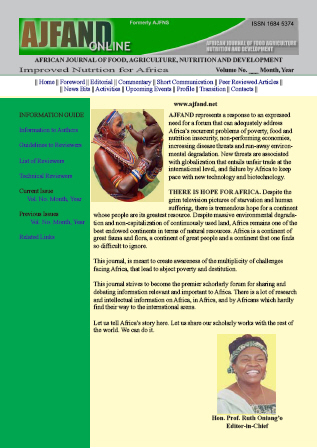
|
African Journal of Food, Agriculture, Nutrition and Development
Rural Outreach Program
ISSN: 1684-5358
EISSN: 1684-5358
Vol. 15, No. 4, 2015, pp. 10182-10197
|
 Bioline Code: nd15037
Bioline Code: nd15037
Full paper language: English
Document type: Research Article
Document available free of charge
|
|
|
African Journal of Food, Agriculture, Nutrition and Development, Vol. 15, No. 4, 2015, pp. 10182-10197
| en |
PLANTAIN, BANANA AND WHEAT FLOUR COMPOSITES IN BREAD MAKING: PROSPECTS FOR INDUSTRIAL APPLICATION
Adeniji, Tajudeen A.
Abstract
Bread is one of the most convenient, least expensive and most important staple foods in the world today. It is usually fermented and baked into loaves or cakes. Bread making has been with the Chinese for 5000 years and has also been found in ancient Egyptian tombs and reported widely in the Old Testament of the Holy Bible and in the Holy Qur’an. Bread was introduced to Nigeria probably about two centuries ago either by white colonialists or it may have been acquired from the Arabs through the Trans-Saharan trade with the Fulanis and Hausas of Northern Nigeria, especially during the eras of Mali and Songhaï Empires. Wheat bread is widely consumed in all parts of Africa. Research into the use of indigenous raw materials in the production of composite bread, cakes and confectionery products has been carried out in several African research institutes and universities. These investigations have proven beyond doubt the baking potentials of various tropical crops including plantain and banana. Improved varieties of plantain and banana have been developed and widely distributed to farmers in West and Central Africa as well as East and Southern Africa by the International Institute of Tropical Agriculture (IITA). This effort was complemented by extensive post-harvest research on new product development and evaluation from various accessions of plantain and banana hybrids. Transformation of fruits at different stages of ripening involving different processing techniques, packaging and preservation of new products was disseminated to farmers and food processors. This was necessary to add value to fresh plantain and banana, reduce post-harvest loss, enhance product diversification and provide jobs. Despite these approaches, there has been limited effort to implement composite bread technology in developing countries at the industrial level. This paper is a review of the application of tropical crops, especially plantain and banana in bread making. Output of this review may provide impetus for sustainable adoption of non-wheat or composite wheat bread making technology in Africa.
Keywords
Plantain; wheat; baking; composite; bread; banana; postharvest; industrial; evaluation; adoption
|
| |
© Copyright 2015 - African Journal of Food, Agriculture, Nutrition and Development
Alternative site location: http://www.ajfand.net/
|
|
